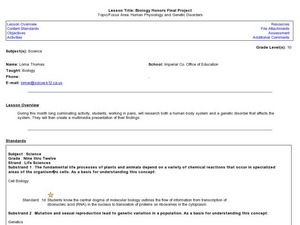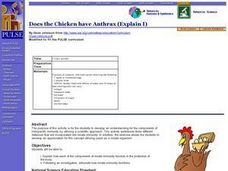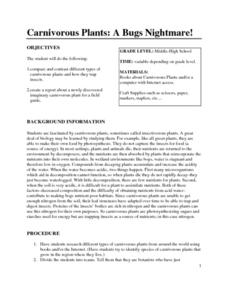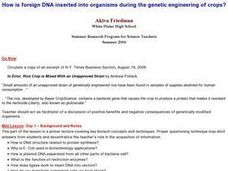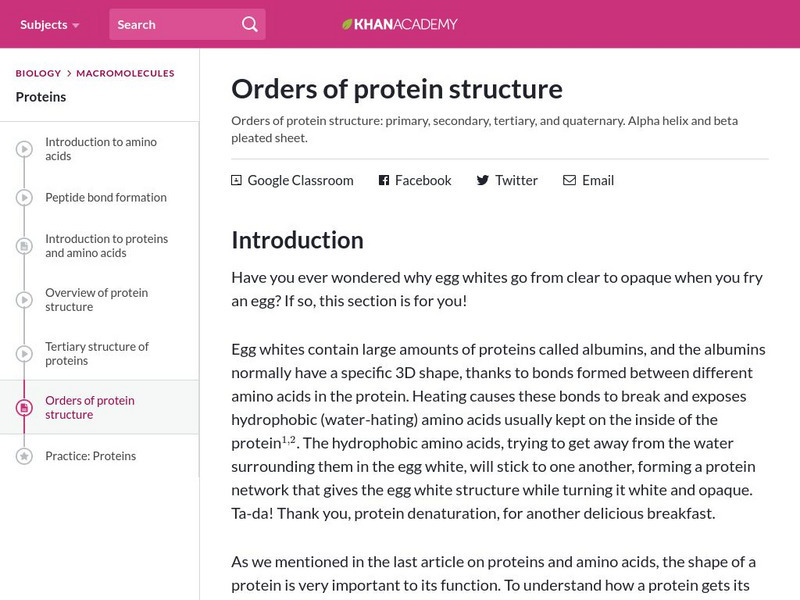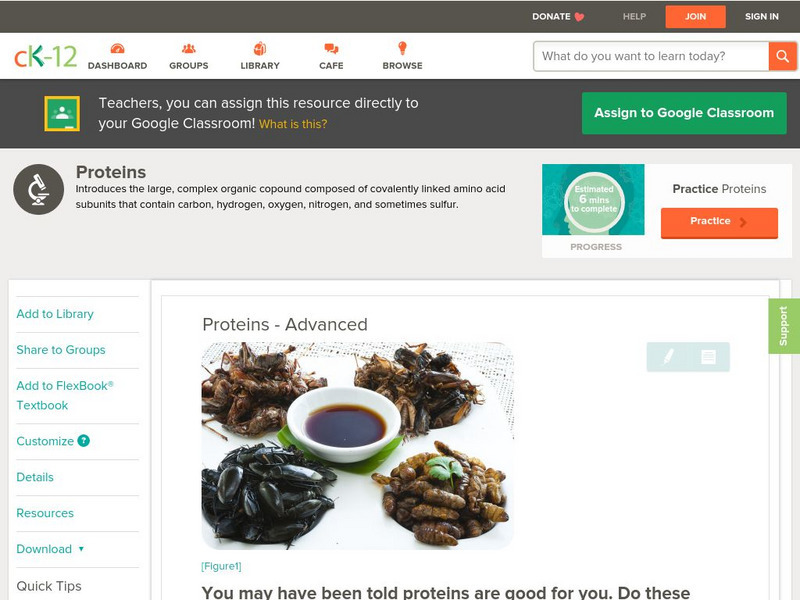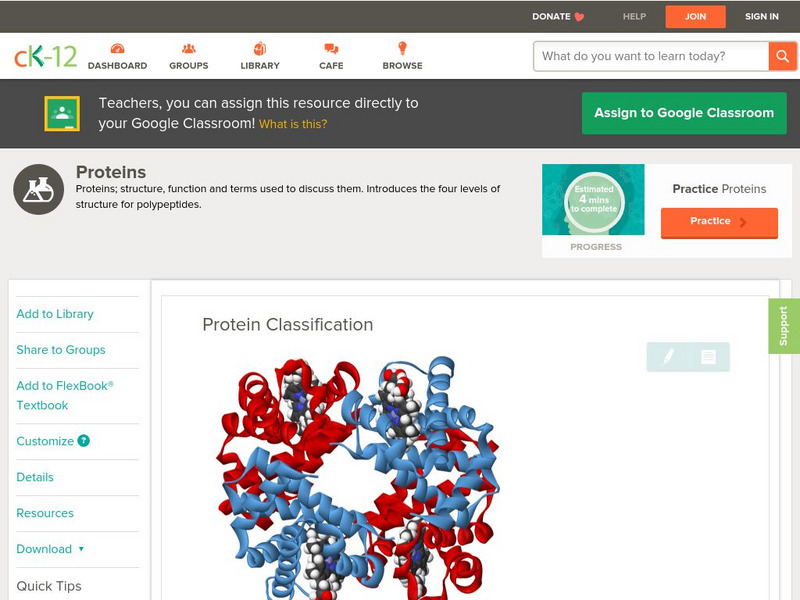Curated OER
DNA Blueprint for Life
Students isolate DNA from different food sources. In this biology lesson, students research DNA extraction. They analyze DNA stands collected from the lab, and compare the differences between each.
Curated OER
Biology Honors Final Project
Tenth graders work on a project about cellular biology and genetics. In this biology lesson, 10th graders research about the assigned human body system and genetic disorders that affect it. They create a multimedia presentation and...
Curated OER
Moore S Word Search Puzzle 1
In this literacy worksheet, learners find the words that are in the word search puzzle that focus upon the vocabulary that is from the theme of the sheet.
Curated OER
What Can Pseudogenes Tell Us About Common Ancestry?
Students compare/constrast DNA sequence data for a portion of the rat GULO gene to the corresponding sequence in the inactive GULO gene in humans, chimpanzees, orangutans, and crab-eating macaques by identifying the shared sequences in...
Curated OER
Does the Chicken have Anthrax (Explain I)
Students explain how each of the components of innate immunity function in the protection of the body. Following an investigation, they articulate how innate immunity functions.
Curated OER
Virus Tracker
Sixth graders will simulate the spread of a virus such as HIV through a population by "sharing" (but not drinking) the water in a plastic cup with several classmates. Although invisible, the water in a few of the cups will already be...
Curated OER
Cells and Cancer
Students idenitfy that cancer is a growth of mutated cells and that cancer cells are only one type of cell that causes disease in our body. They also identify that all eukaryotic cells contain a nucleus, cytoskeleton, and a cell...
Curated OER
Blood Business
Students identify the different kinds of blood. In this biology lesson, students investigate the antigens, agglutinins and Rh factor using their own blood. They use Punnett squares to predict blood type of offspring.
Curated OER
Bacterium Cells
In this bacteria worksheet, learners read several elements of bacterium cells, their diet, types, locations, reproduction, resting stages, effects of, and classification. Students also study a cross-section of bacterium cells.
Curated OER
"Chips" Off the Old Block?
Students study using analogies between common items or occurrences and science concepts. They use the analogy of cookie recipes to that of the DNA "recipes" for living things to help us explain more about mutations.
Curated OER
Eggs, Egg Test, Day 6
Third graders complete a test demonstrating their knowledge of the study of eggs.
Curated OER
Autumn
Students examine the cycle of nutrients in a forest. They research the concepts of decomposing and recycling within a forest.
Curated OER
Carnivorous Plants: A Bugs Nightmare!
Students research carnivorous plants and how they trap insects. They role play as botanists to write a research field guide about a newly discovered imaginary carnivorous plant.
Curated OER
How is Foreign DNA Inserted into Organisms During the Genetic Engineering of Crops?
Students examine the positive benefits and negative consequences of genetically modified organisms following a lecture covering key biotech concepts and techniques. Students then conduct and experiment comparing the travel rate of...
Curated OER
Belonging and Identity
Young scholars participate in a class in which they eat in different social groups. As a class, they discuss the importance of eating a healthy diet and how some foods are harmful to some but not to others. They use the internet to...
Curated OER
Mystery Polymers
Middle schoolers examine how some natural substances are polymers. In this polymer lesson students complete a lab and give examples of a physical change.
Curated OER
What Happens When A Cell Divides?
Students investigate the cycle of mitosis. In this biology activity, students discuss the different stages of mitosis through cell reproduction. They further their investigation through laboratory analysis.
Curated OER
Polymers
Students explore online tutorial on polymers. In this chemistry lesson plan, they create two polymers in the lab and compare their properties. They write a sales letter about their new and improved polymer product.
Khan Academy
Khan Academy: Biology: Macromolecules: Orders of Protein Structure
An article that investigates the levels of protein structure. Understand how the order of the protein structure affects its function.
Concord Consortium
Concord Consortium: Four Levels of Protein Structure
Explore how protein folding creates distinct, functional proteins by examining each of the four different levels of protein structure. (Requires Java)
Concord Consortium
Concord Consortium: Stem Resources: Protein Partnering and Function
A learning module with built-in interactive features where students can read about the differences between large and small molecules, build protein structures, and test their strength under different conditions. They will review polarity...
OpenStax
Open Stax: Protein Synthesis
Most structural components of the cell are made up, at least in part, by proteins and virtually all the functions that a cell carries out are completed with the help of proteins. This site explains protein synthesis, including that of...
CK-12 Foundation
Ck 12: Biology: Proteins
[Free Registration/Login may be required to access all resource tools.] Covers the structure and function of proteins.
CK-12 Foundation
Ck 12: Physical Science: Protein Classification
[Free Registration/Login may be required to access all resource tools.] The structure and function of proteins.

